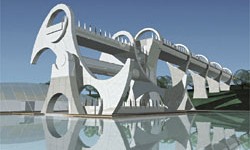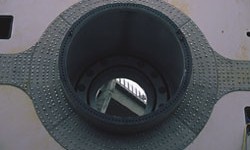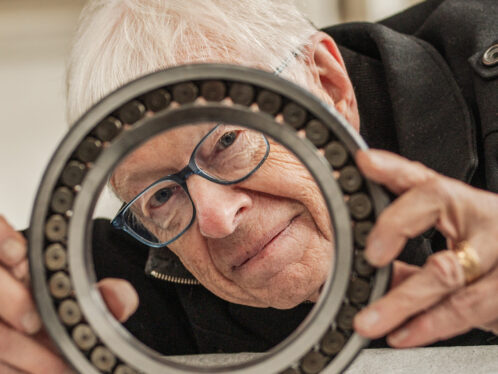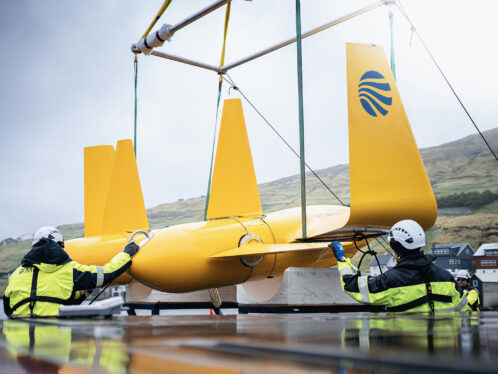
Summary
Inventing the Wheel
Building the world’s first rotating boat lift called for highly specialised skills. When Butterley Engineering of Derbyshire, England, won the contract to build the Falkirk Wheel, design consultant Bennett Associates invited SKF to provide solutions to the wheel’s unique bearing demands.
Working with Bennet Associates, SKF proposed, for the main bearings, two triple-row cylindrical roller bearings mounted on the horizontal axis, one at each end of the wheel.
The bearings are designed to handle both axial and radial loads from the moving wheel. Built at the SKF slewing ring facility in Avallon, France, these 4-metre-diameter bearings are able to support the wheel’s 1,800 tonnes and its payload. Each main bearing is protected from the environment by large diameter clamp seals from SKF – Chicago Rawhide.
Keeping the 460-tonne caissons level as the wheel rotates is crucial, and this is performed by idler gears running on SKF crossed roller bearings. The caissons are supported by bogie wheels running on circular rails fixed into the arms of the wheel structure. The bogie wheels run on SKF sealed double-row spherical roller bearings that require minimal maintenance.
And as with the wheel itself, life expectancy for the main bearings is 120 years.
The Millennium Link is bringing about the rebirth of key waterways between Glasgow and Edinburgh. And at the core of this massive project is the Falkirk Wheel.Scotland in the late 1700s was part of an island nation totally dependent upon water. It looked to the seas at its perimeters to protect it from warring outsiders and to provide it with seemingly limitless supplies of food. And inland, it depended on its fast-running rivers to power the machinery in the clattering foundries and textile plants of the newly emergent Industrial Revolution.
So it should come as no surprise that water figured largely in another institution whose origins date to the 18th century – the nation’s network of canals. These canals revolutionised the transportation of the island’s cargo and people.
Today, in an era of digital everything and near instantaneous trans-global communication, it is difficult to understand the significance of these modest ship canals.
But most inland Scots at the beginning of the Industrial Revolution never set eyes on the surrounding seas, let alone travelled on the vessels that sailed them. Cross-country transportation to these folks meant hours or even days of gruelling discomfort on the rutted muddy cart tracks that passed for highways. Which made the innovations offered by the Forth and Clyde Canal of the 1770s all the more significant. For this was the world’s first sea-to-sea canal waterway.
Rebirth
The glory days of the man-made waterways of central Scotland are long gone. But now, more than 40 years since the last vessel sailed them, the two key canals of the area – the Forth and Clyde and the Union canals – have been reborn. They have been reclaimed from decay and ruin at a cost of 126 million euro (GBP 78 million) by a grandly titled campaign called the Millennium Link.
What’s more, these two waterways from the 18th and 19th centuries, once connected in central Scotland by a series of 11 locks, are soon to be brought together again – by a unique 21st century engineering solution dubbed “the Falkirk Wheel.”
The Falkirk Wheel is the crowning centrepiece of British Waterways’ Millennium Link. Its very concept was grandly ambitious – a giant rotating boat lift, the only one of its kind in the world, capable of carrying up to eight boats at a time, raising and lowering them 35 metres between the boat basin of one canal and the mighty aqueduct of the other. This all takes place at the 27 million euro (GBP 17 million) Falkirk Wheel Interchange.
The visionary nature of the scheme stretches to the site chosen for the Falkirk Wheel. It is more than 70 years since the 11 locks that used to connect the two canals were swallowed by the expansion of urban progress. Thus, British Waterways had to come up with a new location at which to link the canals. While they were at it, they opted to execute the link very differently from how it had been done before: They lengthened the Union Canal by just over 1.3 kilometres westward and then lowered it through two traditional locks. From there they took the canal underground, beneath not only existing housing, a busy road and the main Edinburgh-Glasgow railway line, but also the preciously historic Roman Antonine Wall.
The canal emerges from the hillside atop a grand, 30-metre-tall aqueduct. This nascent architectural landmark juts like a giant dock out into a what will soon be a landscaped amphitheatre hosting a brand new 100-metre-wide water basin adjacent to the Forth and Clyde Canal, where only a year or two before stood the useless desolation of an abandoned open-cast mine. Incorporated into the water basin’s design is a futuristic visitor centre that will provide year-round views of the Falkirk Wheel in action. British Waterways will operate short trips on canal boats that will take in the wheel, and hotel barges are set to operate canal tours between Edinburgh and Glasgow, taking in the wheel along the way.
Cooperative venture
If the project is a product of great ingenuity and determination, it is also one of almost unprecedented cooperation by myriad local and national organisations. No fewer than 15 funding bodies contributed to the hefty project budget, and multiple corporations’ specialities have pushed the landmark forward. Under British Waterways management, construction has been carried out by joint-venture contractor Morrison-Bachy-Soletanche, along with specialists from Ove Arup Consultants and Butterley Engineering of Derbyshire, England. They built the wheel, shipping it to Falkirk in 20 parts and assembled it on site, using more than 20,000 bolts. Custom-designed, four-metre diameter bearings were produced by SKF to meet the massive wheel’s unique requirements (see sidebar story); and architectural services were supplied by Scotland-based RMJM, from initial designs by Nicoll Russell Studios and engineers Binnie Black and Veatch. The result of all this cooperation, says Marischal Ellis, British Waterways’ principal project manager for the Falkirk Interchange, promises to amount to considerably more than merely the sum of its component parts. Which is in line with the target goal of the entire canal reclamation project.
“Re-building the canals is all about the economic regeneration of entire regions and their communities through the re-creation of well-used, peaceful environments,” says Ellis.
“The canals will be huge tourist attractions, to both local and overseas tourists.”
Convenient Access
Little wonder that the people behind the Falkirk Wheel foresee it becoming a huge tourist draw. It is situated in close proximity to such popular tourist magnets as Stirling Castle and the Trossachs, and the newly reclaimed canal links offer convenient access to two main Scottish cities, Glasgow and Edinburgh.
“The Falkirk Wheel is a ground-breaking project,” says Ellis. “Its visitor centre alone is projected to attract up to 200,000 visitors a year. The wheel will not only put Falkirk back on the map, it will put Scotland as a tourist destination and British canals in general back in the public eye.”
Its unique design incorporates twin caissons – 22-metre-long containers that mimic sections of canal, each of which handles a payload of up to 300 tonnes, made up of 250,000 litres of water and up to four boats. Holding the caissons in place are vast 500-tonne twin arms whose shapes are inspired by the Celtic double-headed axe, or Claymore. The arms rotate in a continuous circle, 180 degrees at a time.
The Royal Fine Art Commission for Scotland says of the Falkirk Wheel: “There has been a definite attempt to design the wheel for the 21st century. This design is considered to be a form of contemporary sculpture … a truly exciting solution.”
The connection from one canal to the other once took several hours and involved passage through 11 locks. From early 2002, canal craft will go from the Forth and Clyde boat basin to Union Canal aqueduct – and vice-versa – in 15 minutes.
Scotland’s most famous export is whisky, often referred to as “the water of life.” But in at least one part of the country, there is a new water of life – in the resurrected canals running to and from the Falkirk Wheel.
Ron McMillan
a technology journalist based in Scotland
photos Ron McMillan






